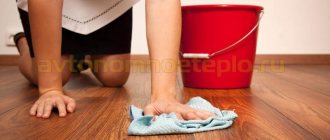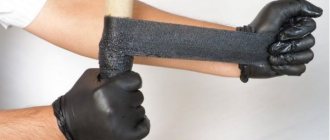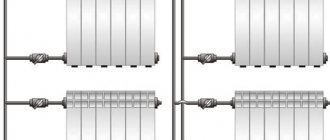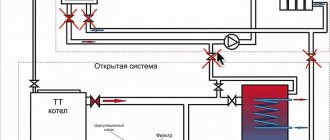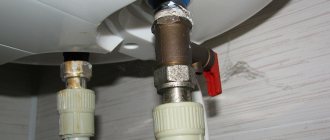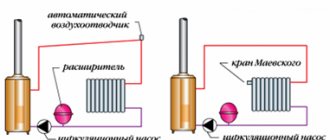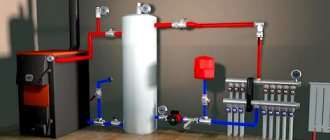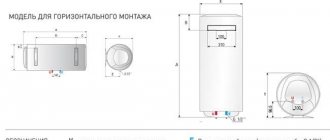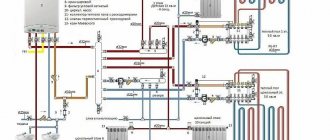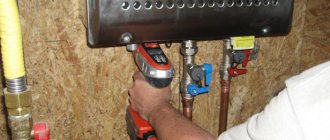When there is often a lack of hot water supply, tenants install water heaters of varying power so as not to heat water on a gas stove and provide the whole family with everything necessary for daily personal hygiene. Modern household appliances are reliable, and their service life if properly used is designed for many years, but sometimes unexpected breakdowns occur: for example, a water heater leaks. Let's look at the reasons why the boiler could suddenly leak, and what needs to be done.
Causes of water heater leaks
The most common cause of leakage is poor joining of supply channels that are loosely connected. In this case, it is necessary to check the joints.
Weak spots can be tightened with a wrench, and faulty pipes can be replaced.
- Another common reason is deformation of the casing, which appears during installation of the boiler, due to violations of the installation instructions.
- Dripping water is visible immediately after the unit is installed.
- Cold liquid decreases in volume and the reservoir contracts.
- After all the water has left the tank, it becomes deformed.
When the reservoir is filled and the liquid is heated, the pressure inside the device increases, causing a leak.
The boiler is leaking: what to do, causes and repair of the malfunction
When your water heater leaks, you need to find the source of the problem as quickly as possible and fix it.
If this is not done, the consequences can be the most unpredictable, and you will have to spend a lot of nerves and money to eliminate them. A faulty boiler can cause flooding not only of your own apartment, but also of your neighbors’ homes if you live in a multi-story building. There is also a risk of electric shock. Leakage from below
One of the most common breakdowns of devices is water leaking out of their top or bottom, which makes it impossible to operate the equipment normally. You need to look for why the boiler is leaking after it has been disconnected from the network and the water supply has been shut off.
Frequent breakdowns in the boiler
You can tell that the tank is leaking by the water that flows down the liner.
The reason for this may be:
- Incorrect installation of the boiler;
- The unit is not connected correctly;
- Water hammer. The tank is designed for a certain pressure, exceeding which results in water hammer, which causes the water heater to leak.
Can a leaking tank be fixed?
In the first three cases described above, the boiler can no longer be repaired. There are a number of reasons for this.
- Most modern water heaters are coated on the inside with glass enamel, which can be destroyed during welding. It is impossible to restore such destruction with your own hands.
- Less commonly, stainless steel and plastic are used as the internal coating of the tank. You can't do much with this material, and you can't even test a stainless steel tank. In short, you shouldn’t waste any time or effort on this.
- A boiler with a tank is an almost monolithic structure; disassembling the device without causing damage to the shell is also unlikely to be possible.
It turns out that the only way out in this situation is to replace the entire storage water heater. You can, of course, try a similar model of the internal tank, try to install it yourself, but in 90% of cases such attempts are doomed to failure due to the reasons stated above.
If the boiler tank is leaking, it is best to replace the device
If the plastic cover of the boiler is leaking, or rather, the control hole in it, then there may be two options for further action. To determine which option is right for you, disconnect the device from the power supply and remove its bottom cover. Find out exactly where it is leaking. If the hatch inside the device leaks, it means that the flange is depressurized, but this malfunction can still be eliminated and the chances of success are high. There are only two reasons for seal failure:
- manufacturing defect - the device was centered incorrectly;
- The rubber gasket-seal on the flange does not perform its functions; it needs to be replaced.
To determine the condition of the gasket, completely drain the tank, remove the gasket, and carefully inspect it for wear or damage. When going to a plumbing store, take it with you to pick up a similar model. Then you change the gasket, attach the cover back and use the water heater again!
Video - Cleaning (replacing) the heating element
A heating element
The accumulation of scale in the heating element often causes boiler leaks. To fix this problem, you need to install a new water heating element.
Not all models of water heaters are equipped with a channel for draining water, which helps with leakage of the tubular heating element—the heating element.
When choosing a water heater, it is best to give preference to models that have a special channel for draining liquid.
There may be several reasons for leakage caused by the heating element:
- Space under bolts;
- Leaking from under the seal.
If a gap has formed under the bolts, then it is necessary to change the heating element; in the second case, you need to tighten the nuts that hold it.
What to do first
First of all, when the boiler leaks, you must immediately disconnect it from the electrical network. Then do a visual inspection to determine where exactly the water is coming from. If the product leaks from the side or top, it means that a hole has formed in the body.
Attention! If water leaks appear, then this is the first signal that the product is not working correctly - there is a problem inside, you should not wait, otherwise you will have to purchase new equipment.
If water leaks from below, this indicates that, at best, the magnesium rod needs to be replaced and the heating element, which is clogged with lime deposits, needs to be cleaned, but a final diagnosis can only be made with an “opening.” If the water heater is leaking, and water is seeping out from under the plugs, and leaks are going through the water supply and drainage hoses, then it is necessary to urgently change the heating element and check the tightness of the connections. Regardless of why the water heater is leaking, it must be dismantled - drain the water, remove it from its mounts and disassemble it to determine the reasons. Any home craftsman can handle this work, but only a professional can establish an accurate diagnosis of what exactly failed and what is the cause of the leak.
Before starting all work, while the water is draining from the water heater, you need to prepare the tools necessary for dismantling:
- a medium-sized adjustable wrench so that you can unscrew the largest nut on the product;
- special tester or multimeter;
- screwdriver and knife;
- set of tubular keys;
- the rubber hose for draining the water is already in operation.
Maintenance and Prevention
Prevention is an important part for an electric water heater, so it should not be neglected so that you do not have to later identify the causes and repair the unit.
When liquid flows down the bolts that secure the heating element, it will need to be replaced because the tank walls are damaged during the welding process.
Water hardness and impurities contained in it negatively affect the operation of the boiler. Sometimes preventative work should be carried out, which consists of:
- Cleaning the device from dirt;
- Replacement of worn out parts.
- With these simple steps you can prevent breakdowns and leaks of your water heater.
Briefly about the main thing
If the water heater is leaking from below , depends on the type of damage. If the replacement elements are damaged, they can be replaced. The boiler often leaks from below; what to do is determined after inspection. If the boiler is leaking from below, the reason may be deformation of the casing, a worn-out heating element, or divergence of seams during installation. You can solve some problems yourself, but sometimes you need to replace the device.
What do you think, if the boiler leaks from below, what should I do?
Manufacturing defects
It happens that the boiler leaks due to mistakes made during its production. If the defect could not be identified at the time of purchasing the unit and it was discovered during operation, then in this case the boiler should be returned to the store.
- Modern devices are such that it is impossible to fix the problem by welding.
- Welding destroys the enamel, causing corrosion.
- Therefore, you need to immediately return the boiler to the seller without trying to repair the device yourself.
Perhaps the cause of the leak arose as a result of a violation of the instructions for installing and installing the unit, then you should carefully re-read the instructions to understand where the mistake was made.
What to do with an Ariston water heater
If you do not clean the internal elements of the device on time or do it excessively, the owners of the device are faced with the fact that the Ariston water heater is leaking. With such care, scale forms, which gradually destroys the equipment part. This happens due to the presence of a large amount of salts in tap water, the high heating temperature of the liquid and untimely replacement of the anode.
It is important to carefully examine every detail to find a leak Source onlinetrade.ru
If your Ariston water heater leaks, you can consult the service center for advice on what to do. It is also possible that the device was damaged during transportation. If the boiler received a strong blow during transportation, the seams will lose integrity and you may notice that the water heater is leaking from below.
Do not forget the fact that errors will be made during installation. For example, they forgot about the safety valve, the parameters of which do not correspond to the pressure in the water main.
Incorrect installation
One of the reasons for a boiler leak is poor installation. You should be wary of inexpensive water heater installation services and carefully study the installation instructions if the installation will be carried out on your own.
A leak can occur due to the following factors:
- Connecting the unit in violation of the pipe insulation rules;
- Connection without expansion tank;
- Lack of leakage prevention valve. If the device is working properly, the water does not overheat, and if it malfunctions, the valve will prevent overheating of the water and, as a consequence, leakage.
- Incorrect installation of the check valve. Such an error has negative consequences that are associated with adding hot water to cold water. Hot water enters the cold water riser, which leads to huge energy consumption.
How to troubleshoot
If the cause of the leak is a faulty valve, then it is replaced with a working part adjusted to the same operating pressure. When replacing, or better yet, while installing a water heater, try not to use cheap Chinese products. Remember that the safety of your family directly depends on the valve. Good Italian safety valves with the same non-separable design, although they cost several times more, are purchased once. As practice shows, there are no problems with them in the future. Connect a flexible transparent hose to the drain outlet of the device. This will help you visually evaluate the performance of the part. Lead the end of the hose into the sewer or a suitable container.
Products from well-known manufacturers are reliable and durable
To remove the valve for replacement or cleaning, you will need a plumber's wrench and an adjustable wrench. The work is performed in this order:
- Disconnect the boiler from the network;
- Turn off the cold water supply tap to the water heater;
- Open the hot water taps and completely drain it from the container;
- Press the lever on the safety valve and remove any remaining liquid from the tank;
- Disconnect the cold water pipeline from the safety valve;
- Remove the valve.
After cleaning or replacement, the part is put back in place in the reverse order.
If the input pressure of your water supply system exceeds the nominal pressure for which the storage water heater is designed (this can be found in the technical data sheet for the device), a pressure reducer is installed at the water inlet to the apartment.
A filter for pre-purification of water must be installed in front of the gearbox, and its installation is carried out in strict accordance with the direction of liquid flow. Approximately half of the pressure reducers have a pressure gauge in their design, which greatly facilitates their setup and control of the parameters of the water supply system.
Storage tanks capable of heating water to a certain temperature (in common parlance - water heaters or boilers) are most often installed in those rooms where there is no centralized supply of hot water, or there is a high probability of its shutdown. This device has not lost its relevance from ancient times to the present day. Thus, the ancient Greek mechanic Heron of Alexandria (second half of the 1st century AD) is rightfully considered the inventor of the boiler. The unit he created heated cold water with steam. Then they forgot about it, and therefore at the end of the 17th - beginning of the 18th centuries they were forced to reinvent the device. But, like any other household electrical appliance, even an advanced water heater can break down as a result of exposure to internal or external factors, as well as due to simple wear and tear of parts. All the reasons why hot water does not come from the boiler, as well as ways to eliminate them, will be described in this material.
Diaphragm and safety valve
It would be a good idea to check the inspection space in the unit cover. The cause of leakage may be low elasticity of the gasket on the flange.
To diagnose, you need to turn off the boiler from the network, remove the bottom cover and carefully inspect the gasket.
If it is worn out, you will have to replace it. The valve is a tap that the manufacturer installs; if the fluid gets too hot, the safety valve will relieve pressure by releasing some of the fluid from the reservoir.
It is necessary to inspect the connection between the valve and the tank and the tap itself. The valve is faulty if it is closed and fluid leaks out.
How to fix a leak yourself
How to identify a breakdown and deal with it yourself.
Installation problems
Soon after connecting, you may notice water dripping from the tank. In this case, the shell of the housing may be inflated or deformed.
When installing it yourself, you forgot about the safety valve, or it was connected incorrectly. As a result, the container overflows with water and swells, after which it leaks. The valve needs to be installed. It protects the system from overpressure.
- If the valve is installed incorrectly or is broken, the tank is deformed when water is drained from the system.
- You turned off the boiler and turned off the water. At this time, the hot water inside cools down and the body contracts.
- The product is filled to capacity with water. When heated, it expands and the tank swells.
If deformed, repair is impossible; a new device will have to be installed.
Impact of corrosion
Has it been a while since you replaced the magnesium anode? Then don't be surprised that the boiler is leaking. Magnesium attracts salts contained in water. As a result, impurities settle on the anode and destroy it, but the tank and heating element remain intact. If the anode has long been destroyed, corrosion of the metal casing begins.
Poor quality pipes or incorrect connections
Is water dripping from pipes or connections? Sealing the connections will help fix and eliminate the problem: you need to replace the gasket or fum tape. It is recommended to use metal-plastic pipes, because the body suffers as a result of water hammer.
Flange (gasket) worn out
The heating element and magnesium anode are mounted on the flange, and a gasket is installed for tightness. If it is worn out, it will leak from below. Replace it with a new one or tighten the fastening nuts.
The heater housing is rusty
A dry heating element has a shell made of steel and enamel - wear leads to corrosion. How to repair a leaking element? Only replacement will help.
Lack of grounding
Why is it necessary to ground the device? When a current breaks down on the housing, the latter will be subject to electrocorrosion. In addition, this is life-threatening: the water from the tap or the surface of the tank can become electric.
If the problem is not worn water heater parts that can be replaced, then the tank cannot be repaired. When the case itself breaks, you have to buy new equipment.
How to avoid malfunction? Only by correct use:
- Make sure that the pressure in the line does not exceed 3 Atm. Otherwise, you need to install a reduction gear.
- Once every six months, inspect the equipment, clean the tank and heater from scale, and change the anode.
- Install a water filter if the water in your area is hard.
It is always better to prevent a breakdown than to repair it. Follow the instructions.
Leak at the top of the boiler
To identify the causes of a leak at the top of the boiler, you must:
- Check all elements of the unit;
- Check the magnesium rod several times a year. This is important so that you do not have to change the magnesium rod often. It is better to do its prevention.
If all the conditions are met, but the water heater is leaking, then you need to take it to the store, if the warranty period has not yet expired, or call a technician.
Mixer dirty
The liquid will flow in a weak stream if the mixer spout
a traffic jam has formed. The pressure will be equally bad for both cold and hot water. To fix the problem, it is necessary to carry out a number of procedures.
- Close the riser to turn off the water.
- Carefully remove the mixer.
- Unscrew the spout from the general body.
- Remove the mesh and rinse it under running water. If salt deposits or heavy dirt forms, let it soak in a special cleaning solution.
- Rinse the faucet spout thoroughly and clean the insides of dirt using a brush.
- Reassemble the mixer in reverse order and install it in place. Don't forget to open the riser.
This procedure may take some time; alternatively, you can simply replace the clogged faucet with a new one. Experts recommend replacing worn parts every few years to avoid serious damage in the future.
Repairing leaks
To carry out repair work you will need the following set of tools:
- Adjustable wrench;
- Tubular and socket wrenches;
- Electrical tester;
- Hose to drain liquid from the reservoir;
- Knife and screwdriver.
Repair work can only be carried out after identifying the cause of the leak. In case of a complete repair that requires special knowledge, it is better to call a specialist.
- The first step is to disconnect the boiler from the power supply and turn off the water valves.
- Then you need to drain the water from the tank using a hose.
- Dismantle the walls and heating element.
- Next, eliminate the leak, in accordance with the cause of the leak.
The main causes of leaks and methods for eliminating them
In the process of leaking the device, it is first necessary to establish the source of the negative factor. They can differ significantly in characteristics, so they can be identified quickly and without professional skills. It is best to study the water heater according to the instructions included with the unit. Most models have a warranty card designed for such situations. To avoid aggravating the problem, the device must not be opened.
Hull deformation
The outer shell of the equipment may become deformed after installation. The cause of the unfavorable behavior of the device is considered to be incorrect installation of the unit. Often the consumer forgets to connect the safety valve. The product is located on the main liquid supply between the shut-off valve and the valve element. This part is designed to protect the tank from overfilling; it is during this process that deformation occurs.
If the valve is installed, but water also flows through the supply pipe, this fuse should be removed and a new one installed. Repairs will not take much time and do not require professional knowledge of the device.
Another reason for deformation is the use of low-quality pipes during installation. Powerful hydraulic shock with pressure changes slowly destroys the structure of the product.
Healthy! If the body is deformed, the boiler cannot be repaired; it must be replaced with a new model, while observing the correct connection technology.
Manufacturing defects
The leakage may be from the top of the housing; if in this situation there are no visual deformations of the unit, and the magnesium rod was mounted during connection, then a manufacturing defect of the equipment is possible. During warranty service, it can be returned back to the supplier.
Modern models are designed with designs in which the tank cannot be repaired. The container cannot be welded, because during the welding process, a layer of enamel breaks off, after which corrosion forms, spreading over the entire surface of the device.
Poor installation of the device
Another reason that occurs quite often is a loose connection to the cold water inlet and hot water outlet pipes. Such signs may appear when installing the device yourself, when low-quality fittings or incorrect materials for seals are used.
Gasket wear
A leak in the inspection hole located in the plastic cover at the bottom of the equipment indicates a loss of elasticity of the rubber gasket on the flange. An accurate determination of this cause can be carried out after turning off the equipment: the lower cap is removed and the problem area is visually examined.
Replacement of the sealing gasket must be carried out strictly in accordance with the boiler model number, so that the product fits tightly to the working parts.
Increased boiler service life
To increase the service life of your water heater, you must carefully study the installation and operation instructions for the unit.
When installing, you should pay attention to some recommendations:
- Take care of grounding before installing the device;
- Prepare the safety valve;
- Study the pressure indicators in the unit, normal pressure is two atmospheres or slightly less. If the pressure is more than three atmospheres, then it should be reduced. This will require a gearbox;
- The temperature in the water heater should be no more than fifty degrees;
- Clean the device and carry out preventive maintenance several times a year, especially pay attention to the rod;
Connect the device through a magnesium filter, which is sold separately. This element will reduce the presence of impurities in water and hardness.
We extend the operation
To ensure that the water heater works properly and does not require major repairs for as long as possible, there are such recommendations.
- The pressure inside the water supply system should not exceed 3 atmospheres; if it is higher, then when installing the device, a reduction gear is installed between the inlet branch of the product and the supply pipe. The reducer needs to be adjusted to 2 atmospheres - this is the ideal pressure for the storage tank of the boiler.
- The internal container and heating element must be regularly cleaned of scale and salt deposits - thereby extending the life of the product.
- Monitor the condition of the magnesium rod - if the length has decreased to a critical level, then it must be urgently changed so that the inner surface of the tank is constantly protected from corrosion.
- Before entering the tank, water heating equipment service specialists advise installing a filter that eliminates the hardness of tap water and traps unwanted impurities.
Important! Adjust the temperature inside the water heater so that it does not exceed 50 °C - this will significantly extend the life of the boiler.
There are many reasons why water heaters leak, but users should immediately disconnect the product from the electrical network, and then carry out a visual inspection. You cannot open the boiler if you do not know exactly the cause of the problem, because your intervention can greatly aggravate the situation - it will get out of control.
Photo instructions for boiler repair
Pressure regulator malfunction
The water pressure reducer is designed to adjust the fluid pressure. Stable operation will prevent leaks and damage to plumbing equipment. However, improper operation of the pressure regulator can lead to problems with the boiler. Let's consider two such situations:
- If the fluid inlet pressure is slightly higher than that set by the manufacturer. Some models of flow-through water heating equipment are equipped with a built-in lock: they will not turn on until the pressure returns to normal. In the case of storage devices, the heated liquid will be released from the valve into the sewer system due to the pressure reducer. This will lead to unnecessary waste of water and electricity.
- If the inlet pressure greatly exceeds that indicated in the equipment passport, leaks or breakdowns of not only water heaters, but also other equipment connected to the water supply: dishwashers and washing machines, thermostats are possible.
Design and principle of operation of water heaters
Let us examine the components and mechanism of operation of the heater in more detail.
Electric boilers come in two types:
- Cumulative.
- Flow-through.
In storage heaters, cold liquid runs through a pipe into an internal container. The temperature increase occurs due to heating elements (tubular electric heaters). The thermostat is responsible for regulating the degree of heating. It monitors whether the water has heated up to the level you set and automatically turns off the heating elements. The tank in which the liquid is located keeps the water heated, thereby saving electricity and the life of electric heaters.
Instantaneous water heaters are characterized by the absence of a tank. The flow of cold water in the pipe comes into contact with the heating element, due to which heating occurs.
